Beautiful stevia. Nary a leaf on the Sweet Leaf plant is touched by munching insects.
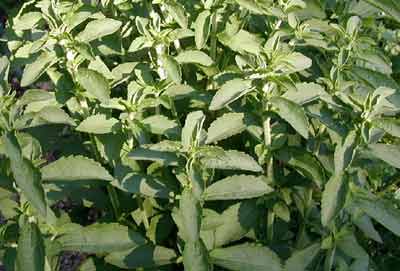
Stevia or sweet leaf plant with leaves intact.
Predatory insects may lie and wait among the symmetrical leaves of Stevia. Ambush predators, that’s what they are!
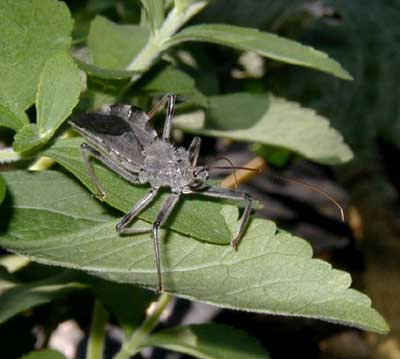
Wheel bug waits on stevia leaf for an unsuspecting passerby.
Stevia is not completely resistant to pests, but not many pests appreciate Stevia’s extremely sweet taste.
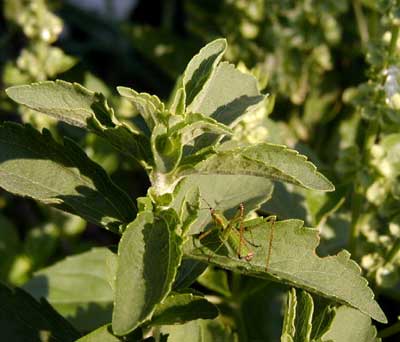
Young grasshopper on stevia leaf.
Inspecting the vegetable and herb gardens this morning I came across this still bumblebee. He was hanging on to the underside of a leaf from the pepper plant, near the basil he must have supped from the previous day. Those tiny little crampons on his feet just held him in place, all night? The warmth of the morning sun had not yet shone on his boudoir, so he must have been still sleeping!
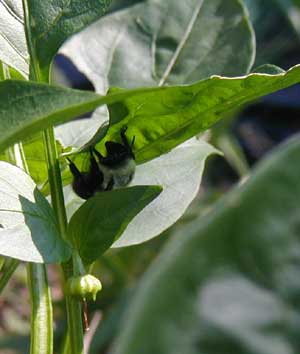
Sleeping bumblebee under a pepper leaf.
The season is about done for the Japanese beetles. They have been terrorizing my peach trees, ornamental maple tree, sassafras trees, and dahlias, too. This morning I captured quit a few from the basil flowers. In they went into a jar of soapy water. Held the jar below the branch and knocked them off. Sometimes they flew away, but the majority was captured.
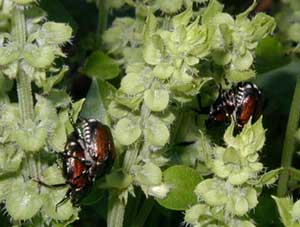
Japanese beetles on basil flowers.
A family of phoebes has been helping me combat the hordes of flying beetles and bugs this summer. Their nest was built atop a lamp that is attached to the house near a garage doorway. They have a habit of sitting at one spot on a branch or post, flying off to catch an insect in mid-air, and then flying back to the same spot on the same branch. Maybe they choose branches with a great view of the insect action, or maybe just high enough to keep the cats in site?
Another pest that we don’t mind seeing around here is the braconid wasp that takes care of a nasty garden pest. Tomato Hornworms are really bad for the tomato eater. These caterpillars grow very quickly and can decimate a tomato or pepper plant very fast! Not only do they eat the leaves, I am mean the entire leaf, they eat the fruits. Your tomato plants will look like sticks if these nasty hornworms are not taken care of. Nature comes to the rescue in the lifecycle of the Braconid wasps. Females lay their eggs in the tomato hornworm caterpillar from which they take nourishment. The hornworm stops feeding and soon dries up to a little black reminant of itself.
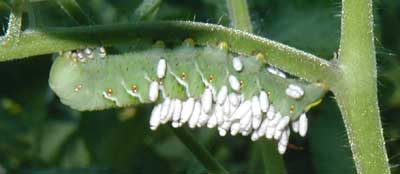
Wasp silk cocoons laid in tomato horn worm on a tomato plant.
To combat the hornworms we pick off any caterpillars that do not have wasp parasites. The caterpillars that are infested with the wasps are left alone to encourage the growth of more wasps. This tactic should help to shift the balance of power to the wasps.
Something ate my stevia down to about an inch above ground. Any idea what would do that?
Hi Barbara!
I surely don’t know. The stevia here seemed to not be bothered by insects. Since your plant was eaten whole we’d suspect a deer or bunny, depending on how large the plant was to begin with. If the edges are jagged, it was probably deer as they don’t have incisors to make a clean cut like a rabbit would. No hoof prints around the base of the plant?
Good luck protecting the remains of the plant. It may grow out ok if there’s some wire mesh wrapped around it to prevent the hungry visitors from finishing it off. Stevia tasted good on their first visit so they’ll be back!